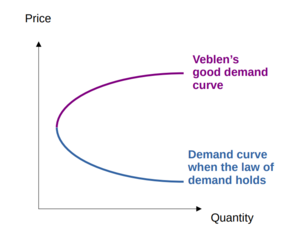Veblen effect: Difference between revisions
From CEOpedia | Management online
(New page created) |
No edit summary |
||
| Line 1: | Line 1: | ||
== | A '''Veblen good''' is a type of luxury good for which demand increases as the price increases, in apparent contradiction to the law of demand, resulting in an upward demand curve. | ||
{{ | |||
==Introduction== | |||
Many years ago Leibenstein (1950) emphasized the significance of the ''signal effect'' the way people consume. This signifies that the utility of a product increases or decreases depending on whether it is purchased and consumed by other consumers. It can also depend on wheter the good has an high or low cost. In marketing, people used to buy luxury goods to impress. It is known that most consumer tacitly accept that luxury goods are bought for social signaling ambitions <ref> Minas Kastanakis & George Balabanis (2011), p.609 </ref>. | |||
==Veblen's Curve== | |||
[[File:Veblencurve.png|right|thumb|Fig. 1 Veblen's curve]] | |||
==Footnotes== | |||
<references/> | |||
==References== | |||
* Minas Kastanakis & George Balabanis (2011), [https://www.acrwebsite.org/volumes/16088/volumes/v38/NA-38 ''Advances in Consumer Research Volume 38''], University of Chicago Press, Duluth. | |||
[[Category:Marketing]] | |||
{{a|MATHIEU Amaury}} | |||
Revision as of 23:17, 25 October 2022
A Veblen good is a type of luxury good for which demand increases as the price increases, in apparent contradiction to the law of demand, resulting in an upward demand curve.
Introduction
Many years ago Leibenstein (1950) emphasized the significance of the signal effect the way people consume. This signifies that the utility of a product increases or decreases depending on whether it is purchased and consumed by other consumers. It can also depend on wheter the good has an high or low cost. In marketing, people used to buy luxury goods to impress. It is known that most consumer tacitly accept that luxury goods are bought for social signaling ambitions [1].
Veblen's Curve
Footnotes
- ↑ Minas Kastanakis & George Balabanis (2011), p.609
References
- Minas Kastanakis & George Balabanis (2011), Advances in Consumer Research Volume 38, University of Chicago Press, Duluth.
Author: MATHIEU Amaury
